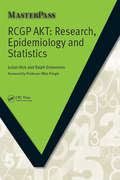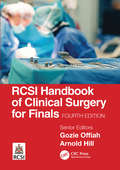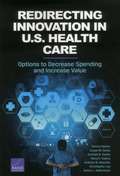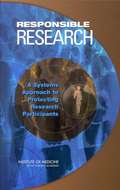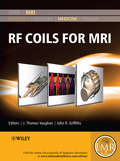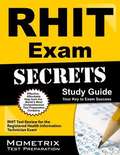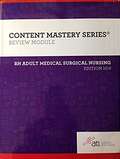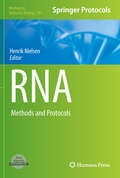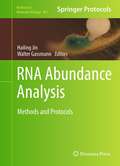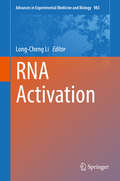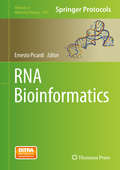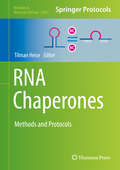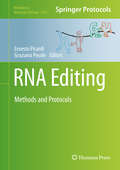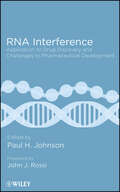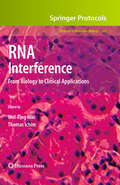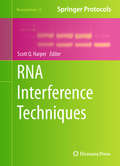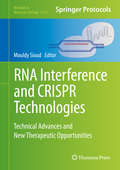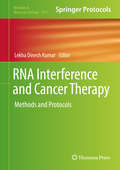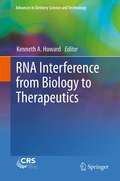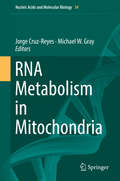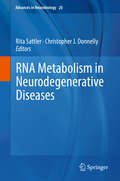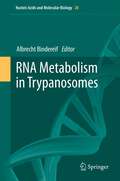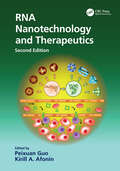- Table View
- List View
RCGP AKT: Research, Epidemiology and Statistics
by Julian Hick Ralph EmmersonThis book has been specifically designed to help GP trainees pass the compulsory AKT examination. Each topic has been skilfully refined to correlate directly with primary care and the RCGP curriculum, revealing how and why critical appraisal and evidence based medicine are essential for good medical practice throughout a career as an independent, k
RCSI Handbook of Clinical Surgery for Finals
by Arnold Hill Gozie OffiahDeveloped over previous editions by the Royal College of Surgeons in Ireland to support students attending the three RCSI universities, this convenient handbook provides pragmatic guidance to the principles and practice of surgery that students can expect to encounter during undergraduate studies. Spanning the full range of surgical specialties, information is presented in a convenient and clinically relevant format that takes the students through the patient journey from presenting symptoms and aetiology to investigations, management and follow-up. The text, written as easy-to-read and easy-to-remember bullet lists, is supplemented throughout by tables, management algorithms and colour illustrations. Key Features: • Concise – specifically for the undergraduate medical student by a highly experienced team of surgical educators • Accessible – bullet text ideal for rapid reference • Flexible – for use when on the ward and during finals revision • Complete - print book supplemented by video clips, online question and answer material and an image library for the full learning and revision package Thoroughly updated, this fifth edition has enhanced pedagogy and, for the first time, is accompanied by video clips and questions for self-testing. Covering the core surgical knowledge needed to become a safe and competent doctor, the book will be an invaluable companion for clinical placements and during the critical run-up to final examinations.
RCSI Handbook of Clinical Surgery for Finals
Developed over three editions by the Royal College of Surgeons of Ireland to support students attending the three RCSI universities, this convenient handbook provides pragmatic guidance to the principles and practice of surgery that students can expect to encounter during undergraduate and early postgraduate studies. Spanning the full range of surgical specialties, information is presented in a convenient and clinically-relevant format that takes the students through the patient journey from presenting symptoms and etiology to investigations, management and follow up. The text, written as easy-to-read and easy-to-remember bullet lists, is supplemented throughout by tables, management algorithms and colour illustrations. Thoroughly updated, this fourth edition is available to customers outside the RCSI universities for the first time. Covering the core surgical knowledge needed to become a safe and competent doctor, the book will be an invaluable companion for clinical placements and during the critical run-up to final examinations.
REDIRECTING INNOVATION IN U.S. HEALTH CARE: Options to Decrease Spending and Increase Value
by Steven Garber Mary E. Vaiana Susan M. Gates Arthur L. Kellermann Emmett B. Keeler Andrew W. Mulcahy Christopher LauNew medical technologies are a leading driver of U. S. health care spending. This report identifies promising policy options to change which medical technologies are created, with two related policy goals: (1) Reduce total health care spending with the smallest possible loss of health benefits, and (2) ensure that new medical products that increase spending are accompanied by health benefits that are worth the spending increases.
RESPONSIBLE RESEARCH: A Systems Approach to Protecting Research Participants
by Committee on Assessing the System for Protecting Human Research ParticipantsWhen 18-year-old Jesse Gelsinger died in a gene transfer study at the University of Pennsylvania, the national spotlight focused on the procedures used to ensure research participants’ safety and their capacity to safeguard the well-being of those who volunteer for research studies.Responsible Research outlines a three-pronged approach to ensure the protection of every participant through the establishment of effective Human Research Participant Protection Programs (HRPPPs). The approach includes: Improved research review processes, Recognition and integration of research participants’ contributions to the system, and Vigilant maintenance of HRPPP performance.Issues addressed in the book include the need for in-depth, complimentary reviews of science, ethics, and conflict of interest reviews; desired qualifications for investigators and reviewers; the process of informed consent; federal and institutional oversight; and the role of accreditation. Recommendations for areas of key interest include suggestions for legislative approaches, compensation for research-related injury, and the refocusing of the mission of institutional review boards. Responsible Research will be important to anyone interested in the issues that are relevant to the practice of using human subjects as research participants, but especially so to policy makers, research administrators, investigators, and research sponsors – but also including volunteers who may agree to serve as research participants.
RF Coils for MRI
by John R. Griffiths J. Thomas VaughanThe content of this volume has been added to eMagRes (formerly Encyclopedia of Magnetic Resonance) - the ultimate online resource for NMR and MRI. To date there is no single reference aimed at teaching the art of applications guided coil design for use in MRI. This RF Coils for MRI handbook is intended to become this reference. Heretofore, much of the know-how of RF coil design is bottled up in various industry and academic laboratories around the world. Some of this information on coil technologies and applications techniques has been disseminated through the literature, while more of this knowledge has been withheld for competitive or proprietary advantage. Of the published works, the record of technology development is often incomplete and misleading, accurate referencing and attribution assignment being tantamount to admission of patent infringement in the commercial arena. Accordingly, the literature on RF coil design is fragmented and confusing. There are no texts and few courses offered to teach this material. Mastery of the art and science of RF coil design is perhaps best achieved through the learning that comes with a long career in the field at multiple places of employment...until now.RF Coils for MRI combines the lifetime understanding and expertise of many of the senior designers in the field into a single, practical training manual. It informs the engineer on part numbers and sources of component materials, equipment, engineering services and consulting to enable anyone with electronics bench experience to build, test and interface a coil. The handbook teaches the MR system user how to safely and successfully implement the coil for its intended application. The comprehensive articles also include information required by the scientist or physician to predict respective experiment or clinical performance of a coil for a variety of common applications. It is expected that RF Coils for MRI becomes an important resource for engineers, technicians, scientists, and physicians wanting to safely and successfully buy or build and use MR coils in the clinic or laboratory. Similarly, this guidebook provides teaching material for students, fellows and residents wanting to better understand the theory and operation of RF coils.Many of the articles have been written by the pioneers and developers of coils, arrays and probes, so this is all first hand information! The handbook serves as an expository guide for hands-on radiologists, radiographers, physicians, engineers, medical physicists, technologists, and for anyone with interests in building or selecting and using RF coils to achieve best clinical or experimental results.About EMR Handbooks / eMagRes Handbooks The Encyclopedia of Magnetic Resonance (up to 2012) and eMagRes (from 2013 onward) publish a wide range of online articles on all aspects of magnetic resonance in physics, chemistry, biology and medicine. The existence of this large number of articles, written by experts in various fields, is enabling the publication of a series of EMR Handbooks / eMagRes Handbooks on specific areas of NMR and MRI. The chapters of each of these handbooks will comprise a carefully chosen selection of articles from eMagRes. In consultation with the eMagRes Editorial Board, the EMR Handbooks / eMagRes Handbooks are coherently planned in advance by specially-selected Editors, and new articles are written (together with updates of some already existing articles) to give appropriate complete coverage. The handbooks are intended to be of value and interest to research students, postdoctoral fellows and other researchers learning about the scientific area in question and undertaking relevant experiments, whether in academia or industry.Have the content of this Handbook and the complete content of eMagRes at your fingertips! Visit: www.wileyonlinelibrary.com/ref/eMagResView other eMagRes publications here
RHIT Exam Secrets Study Guide
by Mometrix Exam Secrets Test Prep Team***Includes Practice Test Questions*** RHIT Exam Secrets helps you ace the Registered Health Information Technician Exam without weeks and months of endless studying.
RN Adult Medical Surgical Nursing (Edition 10.0)
by Assessment Technologies InstituteThis specialized review module book from ATI contains comprehensive nursing content and critical thinking and application exercises. It is organized into units covering the foundations of nursing care (Unit 1), body systems and physiological processes (Unit 2 to 13), and perioperative care (Unit 14).
RN Maternal Newborn Nursing: Review Module Edition 10. 0
by Assessment Technologies InstituteExaminations Study guide for Maternal Newborn Nursing
RNA
by Henrik NielsenRecent insight into the transcripts generated from the mammalian genome (i.e. the transcriptome) has revealed that transcription is a far more complex phenomenon than previously thought. In RNA: Methods and Protocols, expert researchers provide the procedures and methods used to describe the structure of messenger RNAs and non-coding RNAs that are transcribed by RNA polymerase II as the immediate gene products in mammalian cells. Focused on the structure of the RNA products of "gene X" and the mapping of proteins associated with these RNAs, the volume presents appropriate information for non-specialists in RNA biology. Written in the highly successful Methods in Molecular BiologyTM series format, many chapters contain introductions to their respective topics, lists of the necessary materials and reagents, step-by-step, readily reproducible laboratory protocols, and key tips on troubleshooting and avoiding known pitfalls. Comprehensive and practical, RNA: Methods and Protocols views the transcriptional landscape with an appreciation for the role that proteins play in the processing and interpretation of genetic information in an attempt to further our crucial knowledge of the many products and sophisticated regulatory networks that result from it.
RNA Abundance Analysis
by Hailing Jin Walter GassmannRNA abundance analysis is one of the most important approaches for gene expression studies in the field of molecular biology. In RNA Abundance Analysis: Methods and Protocols, expert researchers cover a wide range of techniques on RNA extraction, detection, quantification, visualization, and genome-wide profiling, from conventional methods to state-of-the-art high throughput approaches. This volume includes detailed techniques to examine mRNAs, small non-coding RNAs, protein-associated small RNAs, sulfur-containing RNAs, viral and satellite RNAs, RNA isoforms, and alternatively spliced RNA variants from various organisms, as well as key discussions of computational data processing for genome-wide datasets. Written for the highly successful Methods in Molecular BiologyTM series, chapters include introductions to their respective topics, lists of the necessary materials and reagents, step-by-step, readily reproducible laboratory protocols, and tips on troubleshooting and avoiding known pitfalls. Essential and easy to use, RNA Abundance Analysis: Methods and Protocols provides a comprehensive set of techniques and methods on isolating and analyzing mRNAs, small RNAs, and modified RNAs, which can assist you in your gene expression studies.
RNA Activation
by Long-Cheng LiThis book offers an essential guide to RNA activation (RNAa), an emerging and fascinating new field. RNAa is a small RNA-guided and Argonaute-dependent gene regulation phenomenon in which promoter-targeted short double-stranded RNAs (dsRNAs) induce target gene expression at the transcriptional level. It occurs primarily in the nucleus and can be mediated by artificially designed short duplex RNAs that target regulatory sequences (e.g., promoters, genes’ 3’ termini and enhancers) and naturally occurring small RNAs (e.g., miRNAs and C. elegans 22G-RNAs). With contributions from internationally respected RNA experts, this book provides comprehensive coverage of different RNAa mechanisms and a timely update on recent advances in RNAa research, with a focus on developing RNAa-based therapeutics. Special chapters are also devoted to the topics of gene activation induced by antisense oligonucleotides and the CRISPR system. As the first book to cover RNAa, it will be of interest to a wide audience, from scientists in academia and the pharmaceutical industry to clinicians who wish to further explore the biology of RNAa and related phenomena, so as to harness their full potential for use in biotechnology and drug development.
RNA Bioinformatics
by Ernesto PicardiThis volume provides an overview of RNA bioinformatics methodologies, including basic strategies to predict secondary and tertiary structures, and novel algorithms based on massive RNA sequencing. Interest in RNA bioinformatics has rapidly increased thanks to the recent high-throughput sequencing technologies allowing scientists to investigate complete transcriptomes at single nucleotide resolution. Adopting advanced computational technics, scientists are now able to conduct more in-depth studies and present them to you in this book. Written in the highly successful Methods of Molecular Biology series format, chapters include introductions to their respective topics, lists of the necessary materials and equipment, step-by-step, readily reproducible bioinformatics protocols, and key tips to avoid known pitfalls. Authoritative and practical, RNA Bioinformatics seeks to aid scientists in the further study of bioinformatics and computational biology of RNA.
RNA Chaperones: Methods and Protocols (Methods in Molecular Biology #2106)
by Tilman HeiseThis book provides a wide spectrum of methods to study RNA chaperones in vitro, at the single molecule level, and protocols useful for cell-based assays. Beginning with a section on a number of bacterial proteins for study, the volume also explores proteins from eukaryotic cells and how to delve into the complex interactions between RNA chaperones and the folding and unfolding of proteins. Written for the highly successful Methods in Molecular Biology series, chapters include introductions to their respective topics, lists of the necessary materials and reagents, step-by-step, readily reproducible laboratory protocols, and tips on troubleshooting and avoiding known pitfalls. Authoritative and practical, RNA Chaperones: Methods and Protocols serves as an ideal guide for scientists and students interested in RNA biology and RNA chaperones.Chapter 3 is available Open Access under a Creative Commons Attribution 4.0 International License via link.springer.com.
RNA Editing: Methods and Protocols (Methods in Molecular Biology #2181)
by Ernesto Picardi Graziano PesoleThis volume provides an overview about main RNA editing mechanisms, focusing on their functions in physiological as well as pathological conditions. Chapters guide readers through state- of-the art methodologies to investigate RNA editing through wet and dry approaches. Written in the highly successful Methods in Molecular Biology series format, chapters include introductions to their respective topics, lists of the necessary materials and reagents, step-by-step, readily reproducible laboratory protocols, and tips on troubleshooting and avoiding known pitfalls. Authoritative and cutting-edge, RNA Editing: Methods and Protocols aims to ensure successful results in the further study of this vital field.
RNA Interference
by John J. Rossi Paul H. JohnsonRNA Interference: Application to Drug Discovery and Challenges to Pharmaceutical Development provides a general overview of this rapidly emerging field, with a strong emphasis on issues and aspects that are important to a drug development team. The first part covers more general background of RNA interference and its application in drug discovery. In the second part, the book addresses siRNA (small interfering RNA), a pharmaceutically potent form, and its use and delivery in therapeutics along with manufacturing and delivery aspects.
RNA Interference
by Thomas Ichim Wei-Ping MinFrom the early days when RNA interference was a strange artifact in worms to the 2006 Noble Prize received by Fire and Mello and the current clinical trials, the field of RNA interference has grown at a breakneck pace. In RNA Interference: From Biology to Clinical Applications, expert contributors provide an overview of the most current science and protocols that span the biological disciplines from detailed nucleic acid chemistry, to pharmacology, to the manipulation of signal transduction pathways. Divided into three distinct sections, this volume delves into the physiology of RNA interference, RNA interference in the laboratory and siRNA delivery, and preclinical and clinical issues associated with the use of RNAi-inducing agents as drugs in order to stimulate new questions and offer the tools necessary to start addressing those questions. Written in the highly successful Methods in Molecular BiologyTM series format, chapters include introductions to their respective topics, lists of the necessary materials and reagents, step-by-step, readily reproducible laboratory protocols, and notes on troubleshooting and avoiding known pitfalls. Authoritative and inspiring, RNA Interference: From Biology to Clinical Applications aims to promote and motivate innovation by reviewing what has been done, providing details of how it has been done, and encouraging speculation on what the future may hold.
RNA Interference Techniques
by Scott Q. HarperNon-coding, inhibitory microRNAs have emerged as important modulators of cellular gene expression, through a process called RNA interference (RNAi). To date, hundreds of conserved and species-specific microRNAs have been identified in organisms ranging from single-celled algae to humans. Many of these tiny RNAs are now known to play fundamental roles in developmental biology and disease pathogenesis. In addition, RNAi has emerged as a technology useful for manipulating gene expression. In RNA Interference Techniques, expert researchers present detailed methods for designing and delivering artificial inhibitory RNAs to neural tissue and for detecting or cloning endogenous microRNAs, all in order to aid investigators' attempts to ask basic biological questions or develop therapeutics for dominant neurogenetic disorders, cancer, or viral infection. As a volume in the successful Neuromethods series, the chapters provide authoritative accounts of the most commonly used approaches in the field today. Cutting-edge and concise, RNA Interference Techniques promises to support the vital research in the field of RNAi and miRNAs, ever-continuing to grow rapidly and gain increasing importance in basic and translational biology.
RNA Interference and CRISPR Technologies: Technical Advances and New Therapeutic Opportunities (Methods in Molecular Biology #2115)
by Mouldy SioudThis volume explores the uses of RNAi and CRISPR interferences as a general method for inhibiting gene expression, with focus on their biological functions, design, chemical modifications, delivery, and preclinical/clinical applications. In addition to relevant backgrounds, the chapters in this book discuss simple and accurate protocols dealing with the latest advances in RNAi and CRISPR applications and look at how these methods differ from one another. Written in the highly successful Methods in Molecular Biology series format, chapters include introductions to their respective topics, lists of the necessary materials and reagents, step-by-step, readily reproducible laboratory protocols, and tips on troubleshooting and avoiding known pitfalls.Comprehensive and cutting-edge, RNA Interference and CRISPR Technologies: Technical Advances and New Therapeutic Opportunities is a valuable resource for any scientist, teachers, graduate student, postdoc, and clinician interested in this field. This book also benefits anyone in research and development in biotech and pharmaceutical companies who want to understand more about these technologies, and their applications in biology and medicine.
RNA Interference and Cancer Therapy: Methods and Protocols (Methods in Molecular Biology #1974)
by Lekha Dinesh KumarThis comprehensive volume collects a repertoire of techniques for the adoption and exploitation of RNA interference (RNAi) as a fertile strategy to develop the bio-drugs of future in the vital field of cancer research. Exploring the immense ‘bench to bedside’ potential of RNAi as a therapeutic molecule, the book focuses many of its chapters on nanoparticle-based targeted deliveries, including aptamers, as well as techniques for using RNAi technology to combat various cancers in preclinical studies. Each of the 26 chapters is authored by the pioneers in the respective areas and thus provides a practical and empirical account of the techniques that could be used as benchmark tools in the area of cancer research. Written for the highly successful Methods in Molecular Biology series, chapters include introductions to their respective topics, lists of the necessary materials and reagents, step-by-step, readily reproducible laboratory protocols, and tips on troubleshooting and avoiding known pitfalls. Authoritative and essential, RNA Interference and Cancer Therapy: Methods and Protocols provides the necessary guidance for both novice and professional researchers who intend to discover and innovate newer means of using RNAi technology to combat cancer, one of the greatest scourges of human health.
RNA Interference from Biology to Therapeutics
by Kenneth A. HowardThe enormous potential of siRNA as a therapeutic has led to an explosion of interest from the scientific community. There has been intense interest from Big Pharma to capitalise on this new technology but the fact remains that delivery is a key determinant in realizing the full clinical potential of RNA interference. There is an urgent need for better delivery methods to take this technology forward. This book addresses the role of different RNAi molecules in cellular processes as rational for diagnostic and therapeutic approaches. This book will cover RNAi therapeutic design to optimize siRNA potency and reduce off-target effects and current delivery technologies to overcome both intracellular and extracellular barriers. The reader will gain an insight into RNA interference from the cellular mechanisms to screening to siRNA design right through to diagnostic and therapeutic applications.
RNA Metabolism in Mitochondria (Nucleic Acids and Molecular Biology #34)
by Jorge Cruz-Reyes Michael W. GrayThis volume focuses on mitochondrial RNA metabolism, emphasizing recent discoveries and technological advances in this fast moving area that increase our understanding of mitochondrial gene function. Topics addressed include the interplay of mitochondria with the nucleus and cytosol, structure-function connections, and relevance to human disease. Mitochondria are the powerhouses of the cell, and a great deal is known about mitochondrial energy metabolism. Less well known is the plethora of amazing mechanisms that have evolved to control expression of mitochondrial genomes. Several RNA processes and machineries in protozoa, plants, flies and humans are discussed, including: transcription and RNA polymerase mechanism; tRNA processing of 5′ and 3′ ends; mRNA maturation by nucleotide insertion/deletion editing and by RNA splicing; mRNA stability; and RNA import. Specialized factors and ribonucleoproteins (RNPs) examined include pentatricopeptide repeat (PPR) proteins, RNase P, polymerases, helicases, nucleases, editing and repair enzymes. Remarkable features of these processes and factors are either not found outside mitochondria, differ substantially among eukaryotic lineages, or are unique in biology.
RNA Metabolism in Neurodegenerative Diseases (Advances in Neurobiology #20)
by Rita Sattler Christopher J. DonnellyIt has become evident over the last years that abnormalities in RNA processing play a fundamental part in the pathogenesis of neurodegenerative diseases. Cellular viability depends on proper regulation of RNA metabolism and subsequent protein synthesis, which requires the interplay of many processes including transcription, pre--‐mRNA splicing, mRNA editing as well as mRNA stability, transport and translation. Dysfunction in any of these processes, often caused by mutations in the coding and non--‐ coding RNAs, can be very destructive to the cellular environment and consequently impair neural viability. The result of this RNA toxicity can lead to a toxic gain of function or a loss of function, depending on the nature of the mutation. For example, in repeat expansion disorders, such as the newly discovered hexanucleotide repeat expansion in theC9orf72 gene found in amyotrophic lateral sclerosis (ALS) and frontotemporal dementia (FTD), a toxic gain of function leads to the formation of RNA foci and the sequestration of RNA binding proteins (RBPs). This in return leads to a loss of function of those RBPs, which is hypothesized to play a significant part in the disease progression of ALS and FTD. Other toxicities arising from repeat expansions are the formation of RNA foci, bi--‐directional transcription and production of repeat associated non--‐ATG (RAN) translation products.This book will touch upon most of these disease mechanisms triggered by aberrant RNA metabolism and will therefore provide a broad perspective of the role of RNA processing and its dysfunction in a variety of neurodegenerative disorders, including ALS, FTD, Alzheimer’s disease, Huntington’s disease, spinal muscular atrophy, myotonic dystrophy and ataxias. The proposed authors are leading scientists in the field and are expected to not only discuss their own work, but to be inclusive of historic as well as late breaking discoveries. The compiled chapters will therefore provide a unique collection of novel studies and hypotheses aimed to describe the consequences of altered RNA processing events and its newest molecular players and pathways.
RNA Metabolism in Trypanosomes
by Albrecht BindereifTrypanosomes are unicellular protozoa of ancient evolutionary origin that are responsible for several tropical diseases, such as African sleeping sickness. Over the last few decades, research in trypanosome biology has revealed many unique and fascinating features, many of which have helped to establish new paradigms in other biological systems. This applies in particular to studies in gene expression and regulation, which benefit enormously from the trypanosome genome projects and from the new genome-wide approaches recently introduced in trypanosome research. This volume covers the most important aspects of biosynthesis, processing, and functions of RNA in trypanosomes, ranging from transcription to RNA editing, mRNA splicing/translation/turnover, processing of transfer and ribosomal RNA, RNA interference, and current transcriptome-wide analyses. Recent progress in RNA-focused research in trypanosomatids promises to yield novel insights into trypanosome-specific features, as well as to reveal in the process new potential therapeutic strategies for combating these parasitic diseases.
RNA Nanotechnology and Therapeutics
by Peixuan Guo Kirill A. AfoninInterest in RNA nanotechnology has increased in recent years as recognition of its potential for applications in nanomedicine has grown. Edited by the world's foremost experts in nanomedicine, this comprehensive, state-of-the-art reference details the latest research developments and challenges in the biophysical and single molecule approaches in RNA nanotechnology. In addition, the text also provides in-depth discussions of RNA structure for nanoparticle construction, RNA computation and modeling, single molecule imaging of RNA, RNA nanoparticle assembly, RNA nanoparticles in therapeutics, immunorecognition of RNA nanomaterials, RNA chemistry for nanoparticle synthesis, and conjugation and labeling. Presents the latest research and discoveries in RNA nanotechnology Features contributions from world-class experts in the field Covers RNA nanoparticles in therapeutics Describes self-assembled RNA nanoparticles
